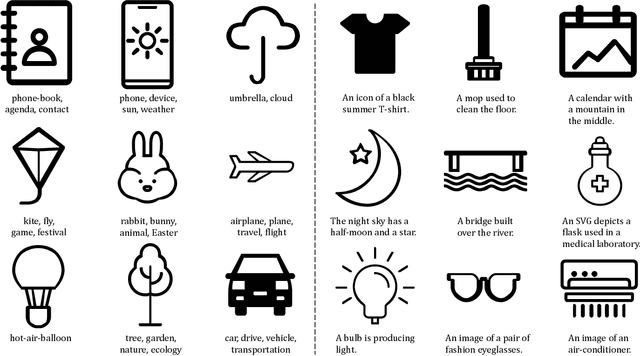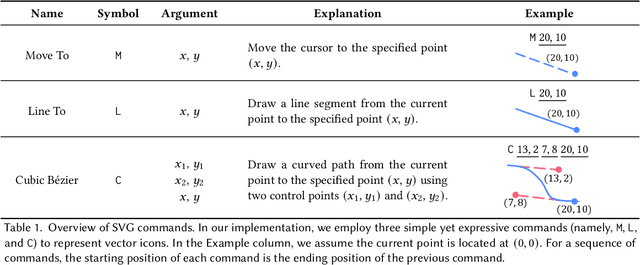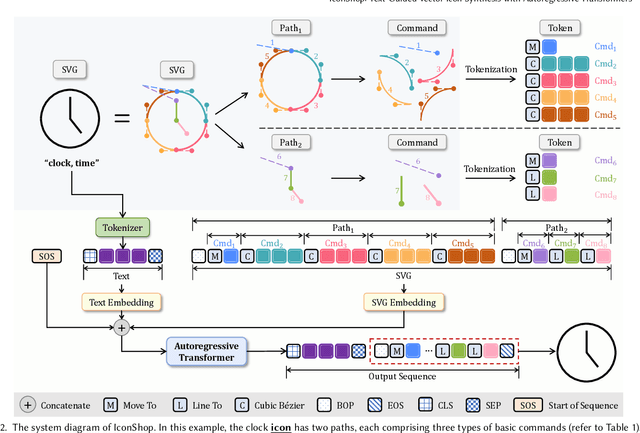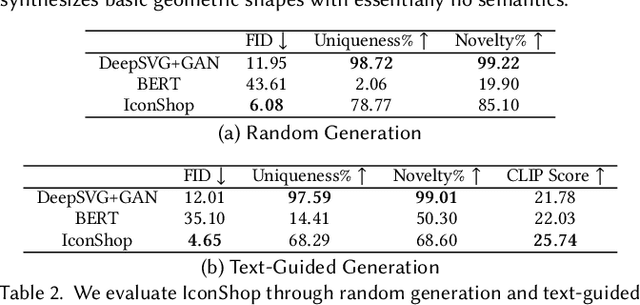Ronghuan Wu
Chat2SVG: Vector Graphics Generation with Large Language Models and Image Diffusion Models
Nov 25, 2024



Abstract:Scalable Vector Graphics (SVG) has become the de facto standard for vector graphics in digital design, offering resolution independence and precise control over individual elements. Despite their advantages, creating high-quality SVG content remains challenging, as it demands technical expertise with professional editing software and a considerable time investment to craft complex shapes. Recent text-to-SVG generation methods aim to make vector graphics creation more accessible, but they still encounter limitations in shape regularity, generalization ability, and expressiveness. To address these challenges, we introduce Chat2SVG, a hybrid framework that combines the strengths of Large Language Models (LLMs) and image diffusion models for text-to-SVG generation. Our approach first uses an LLM to generate semantically meaningful SVG templates from basic geometric primitives. Guided by image diffusion models, a dual-stage optimization pipeline refines paths in latent space and adjusts point coordinates to enhance geometric complexity. Extensive experiments show that Chat2SVG outperforms existing methods in visual fidelity, path regularity, and semantic alignment. Additionally, our system enables intuitive editing through natural language instructions, making professional vector graphics creation accessible to all users.
AniClipart: Clipart Animation with Text-to-Video Priors
Apr 18, 2024



Abstract:Clipart, a pre-made graphic art form, offers a convenient and efficient way of illustrating visual content. Traditional workflows to convert static clipart images into motion sequences are laborious and time-consuming, involving numerous intricate steps like rigging, key animation and in-betweening. Recent advancements in text-to-video generation hold great potential in resolving this problem. Nevertheless, direct application of text-to-video generation models often struggles to retain the visual identity of clipart images or generate cartoon-style motions, resulting in unsatisfactory animation outcomes. In this paper, we introduce AniClipart, a system that transforms static clipart images into high-quality motion sequences guided by text-to-video priors. To generate cartoon-style and smooth motion, we first define B\'{e}zier curves over keypoints of the clipart image as a form of motion regularization. We then align the motion trajectories of the keypoints with the provided text prompt by optimizing the Video Score Distillation Sampling (VSDS) loss, which encodes adequate knowledge of natural motion within a pretrained text-to-video diffusion model. With a differentiable As-Rigid-As-Possible shape deformation algorithm, our method can be end-to-end optimized while maintaining deformation rigidity. Experimental results show that the proposed AniClipart consistently outperforms existing image-to-video generation models, in terms of text-video alignment, visual identity preservation, and motion consistency. Furthermore, we showcase the versatility of AniClipart by adapting it to generate a broader array of animation formats, such as layered animation, which allows topological changes.
IconShop: Text-Based Vector Icon Synthesis with Autoregressive Transformers
Apr 27, 2023



Abstract:Scalable Vector Graphics (SVG) is a prevalent vector image format with good support for interactivity and animation. Despite such appealing characteristics, it is generally challenging for users to create their own SVG content because of the long learning curve to comprehend SVG grammars or acquaint themselves with professional editing software. Recent progress in text-to-image generation has inspired researchers to explore image-based icon synthesis (i.e., text -> raster image -> vector image) via differential rendering and language-based icon synthesis (i.e., text -> vector image script) via the "zero-shot" capabilities of large language models. However, these methods may suffer from several limitations regarding generation quality, diversity, flexibility, and speed. In this paper, we introduce IconShop, a text-guided vector icon synthesis method using an autoregressive transformer. The key to success of our approach is to sequentialize and tokenize the SVG paths (and textual descriptions) into a uniquely decodable command sequence. With such a single sequence as input, we are able to fully exploit the sequence learning power of autoregressive transformers, while enabling various icon synthesis and manipulation tasks. Through standard training to predict the next token on a large-scale icon dataset accompanied by textural descriptions, the proposed IconShop consistently exhibits better icon synthesis performance than existing image-based and language-based methods both quantitatively (using the FID and CLIP score) and qualitatively (through visual inspection). Meanwhile, we observe a dramatic improvement in generation diversity, which is supported by objective measures (Uniqueness and Novelty). More importantly, we demonstrate the flexibility of IconShop with two novel icon manipulation tasks - text-guided icon infilling, and text-combined icon synthesis.
 Add to Chrome
Add to Chrome Add to Firefox
Add to Firefox Add to Edge
Add to Edge